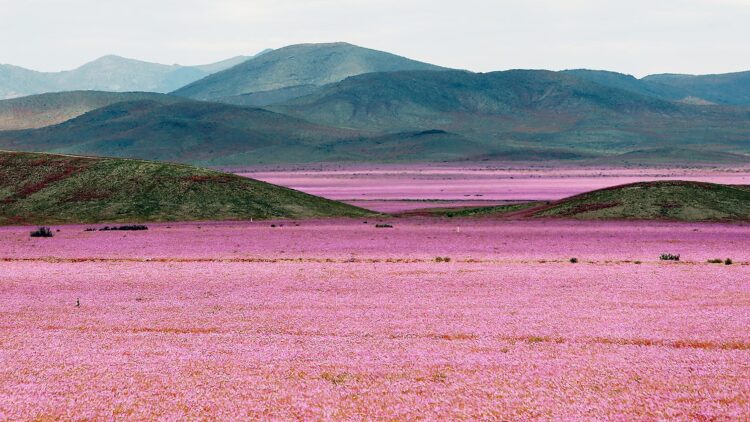Without a doubt, it is one of the driest deserts in the entire world, yet the Atacama Desert in northern Chile is currently experiencing a stunning floral explosion. This extraordinary transformation is spurred by rainfall that has been elusive for centuries, awakening dormant seeds and blanketing the landscape with vibrant white and purple flowers. As the Southern Hemisphere’s winter progresses, the phenomenon has caught the attention of scientists and nature enthusiasts alike.
Atacama Desert: A rare blooming event that showcases Mother Nature’s splendor
Known as the Desierto Florido or “flowering desert,” the Atacama Desert typically showcases its floral displays during the spring. However, this year’s bloom is notably early, thanks to rainfall driven by the El Niño weather phenomenon.
Usually, the blooms occur in spring when the right conditions—specifically, at least 0.6 inches of rainfall—activate the seeds that can remain dormant for up to 15 years. This year, about 0.4 inches of rain fell in mid-April. Combined with morning fog known locally as a “camanchaca,” this triggered the growth of two prominent flower species: the vivid fuchsia “pata de guanaco” (Cistanthe grandiflora) and the delicate white “sighs of the field” (Nolana baccata).
César Pizarro, head of biodiversity conservation at Chile’s National Forestry Corporation in Santiago, reported that the blooming has spread across an area between 115 and 155 square miles of the Atacama Desert.
For the sake of comparison, a fully flowering desert can span approximately 5,800 square miles and typically feature over 200 different floral species.
Atacama Desert: Environmental factors and experts’ future predictions
El Niño has a considerable influence on precipitation levels in the region, thereby increasing the likelihood of rainfall and subsequent flower blooming events. Historically, the last notable winter bloom took place in 2015 when similar early rains stimulated plant activity. However, experts warn that this year’s blooms could actually be short-lived.
Francisco Squeo, president of the Institute of Ecology and Biodiversity in Coquimbo, cautions that if La Niña takes place soon, the floral patches seen blooming now in winter may well be the last we see for this decade.
The blooming event raises concerns regarding its sustainability. María Fernanda Pérez, a Chilean ecologist, explains that while herbaceous plants are able to self-pollinate in the absence of pollinators, this mechanism activates late in the flowering period.
“If the seeds germinate and flower but the pollinators do not arrive, the seeds run out,” says Pérez.
This lack of pollination could jeopardize the future of these blooms and their contribution to the desert’s ecosystem.
Conservation efforts in the Atacama Desert
In response to this floral phenomenon, the Chilean government announced the establishment of a new national park in the Atacama Desert in 2022. This initiative seeks to protect these rare blooms and the diverse fauna they support—this includes various bird, insect, and reptile species.
Pizarro highlighted the importance of these conservation efforts, saying, “This very arid soil houses a treasure. [A] seed bank that has been resilient.”
Additionally, climate change intensifies the vulnerability of this ecosystem, possibly resulting in more frequent anomalous events such as this year’s winter bloom. As temperatures increase, the fragile balance of the desert’s flora could be disrupted, thus giving way to invasive species or decreasing biodiversity.
The Atacama Desert’s floral display serves as a reminder of nature’s resilience and precariousness in the face of climate change. While the current bloom is beautiful, it also emphasizes the delicate interdependence between plants and their pollinators. As scientists continue to investigate these events, the future of Chile’s flowering desert remains uncertain, leaving us to reflect on what lies ahead for this extraordinary ecosystem.

